The Variability in the Thermophysical Properties of Soils for Sustainability of the Industrial-Affected Zone of the Siberian Arctic
Abstract
1. Introduction
- (i)
- The spectral characteristics of the ground cover in order to evaluate the homogeneity of plots and the level of transformation within the plots in comparison to the background landscapes;
- (ii)
- The range of the soil thermal regime in comparison to the typical disturbed and background landscapes;
- (iii)
- Changes in the values of the thermal conductivity coefficient calculated from the field measurement data of vertical profiles of temperature and heat flow;
- (iv)
- Changes in the values of the thermal diffusivity coefficient and moisture content determined by numerical methods using long-term temperature observation data.
2. Materials and Methods
2.1. Territory of Research
2.2. Vegetation
2.3. Soils
2.4. Methods
- (1)
- The heat transfer process must be nearly one-dimensional, which is accurate in the absence of a sufficient amount of large-scale horizontal heterogeneity in the soil properties and the surface heat flow;
- (2)
- The soil properties must not undergo abrupt changes in time, but the model is still applicable if there is sufficient spatial dependency.
2.5. The Error Analysis
3. Results
3.1. The State of Vegetation in Landscapes
3.2. The Test Sites’ Soil Characteristics
3.3. Field Measurements and Modeling of Temperatures and Heat Flow in Soil
4. Discussion
5. Conclusions
Author Contributions
Funding
Institutional Review Board Statement
Informed Consent Statement
Data Availability Statement
Acknowledgments
Conflicts of Interest
Abbreviations
| PMF | Permafrost |
| RSG | Reference soil group |
| STL | The depth of the seasonally thawed layer |
| PC | Physical clay (<0.01 mm) content |
| MC | Soil moisture content |
| SD | Specific density |
| OM | Organic matter |
| BD | Bulk density |
| GMTED | Global multi-resolution terrain elevation data |
| SA | Ambarnaya River test site |
| SA1 | Observation point 1 at SA test site |
| SA2 | Observation point 2 at SA test site |
| SB | Boganida River test site |
References
- Orgogozo, L.; Prokushkin, A.S.; Pokrovsky, O.S.; Grenier, C.; Quintard, M.; Viers, J.; Audry, S. Water and energy transfer modeling in a permafrost-dominated, forested catchment of Central Siberia: The key role of rooting depth. Permafr. Periglac. Process. 2019, 30, 75–89. [Google Scholar] [CrossRef]
- Anisimov, O.A.; Sherstiukov, A.B. Evaluating the effect of environmental factors on permafrost in Russia. Earth’s Cryosph. 2016, 2, 78–86. (In Russian) [Google Scholar]
- Ponomareva, T.V.; Litvintsev, K.Y.; Finnikov, K.A.; Yakimov, N.D.; Sentyabov, A.V.; Ponomarev, E.I. Soil Temperature in Disturbed Ecosystems of Central Siberia: Remote Sensing Data and Numerical Simulation. Forests 2021, 12, 994. [Google Scholar] [CrossRef]
- Xavier, T.; Orgogozo, L.; Prokushkin, A.S.; Alonso-González, E.; Gascoin, S.; Pokrovsky, O.S. Future permafrost degradation under climate change in a headwater catchment of central Siberia: Quantitative assessment with a mechanistic modelling approach. Cryosphere 2024, 18, 5865–5885. [Google Scholar] [CrossRef]
- Vasiliev, A.A.; Drozdov, D.S.; Gravis, A.G.; Malkova, G.V.; Nyland, K.E.; Streletskiy, D.A. Permafrost degradation in the Western Russian Arctic. Environ. Res. Lett. 2020, 15, 045001. [Google Scholar] [CrossRef]
- Langer, M.; von Deimling, T.S.; Westermann, S.; Rolph, R.; Rutte, R.; Antonova, S.; Rachold, V.; Schultz, M.; Oehme, A.; Grosse, G. Thawing permafrost poses environmental threat to thousands of sites with legacy industrial contamination. Nat. Commun. 2023, 14, 1721. [Google Scholar] [CrossRef]
- Anisimov, O.A. Retrospective Analysis of Permafrost Bearing Capacity during the Period of Intensive Arctic Development (1950–2022). Russ. Meteorol. Hydrol. 2025, 50, 42–49. [Google Scholar] [CrossRef]
- Yurkevich, N.V.; Eltsov, I.N.; Gureev, V.N.; Mazov, N.A.; Yurkevich, N.V.; Edelev, A.V. Technogenic effect on the environment in the Russian Arctic by the example of the Norilsk industrial area. Bull. Tomsk. Polytech. University. Geo Assets Eng. 2021, 332, 230–249. (In Russian) [Google Scholar] [CrossRef]
- Lebedeva, L.; Semenova, O.; Vinogradova, T. Simulation of Active Layer Dynamics, Upper Kolyma, Russia, using the Hydrograph Hydrological Model. Permafr. Periglac. Process. 2014, 25, 270–280. [Google Scholar] [CrossRef]
- Desyatkin, R.V.; Desyatkin, A.R.; Fedorov, P.P. Temperature regime of taiga cryosoils of Central Yakutia. Earth’s Cryosph. 2012, 16, 70–78. (In Russian) [Google Scholar]
- Ponomareva, T.V.; Tretyakov, P.D.; Ponomarev, E.I. Long-Term Dynamics of Soil Temperature Regime along the Latitude Gradient in the Permafrost Zone of Central Siberia. Contemp. Probl. Ecol. 2025, 18, 160–170. (In Russian) [Google Scholar] [CrossRef]
- Yakimov, N.D.; Ponomarev, E.I.; Ponomareva, T.V. Variation in spectral indices in the context of natural and technogenic transformations of landscapes. Sovrem. Probl. Distantsionnogo Zondirovaniya Zemli Iz Kosm. 2024, 21, 131–140. (In Russian) [Google Scholar] [CrossRef]
- Philipp, M.; Dietz, A.; Buchelt, S.; Kuenzer, C. Trends in Satellite Earth Observation for Permafrost Related Analyses—A Review. Remote Sens. 2021, 13, 1217. [Google Scholar] [CrossRef]
- Yanagiya, K.; Furuya, M.; Danilov, P.; Iwahana, G. Transient freeze-thaw deformation responses to the 2018 and 2019 fires near Batagaika megaslump, Northeast Siberia. J. Geophys. Res. Earth Surf. 2023, 128, e2022JF006817. [Google Scholar] [CrossRef]
- Sadeghi Chorsi, T.; Meyer, F.J.; Dixon, T.H. Toward long-term monitoring of regional permafrost thaw with satellite interferometric synthetic aperture radar. Cryosphere 2024, 18, 3723–3740. [Google Scholar] [CrossRef]
- Crichton, K.A.; Anderson, K.; Fewster, R.E.; Charman, D.J.; Garneau, M.; Väliranta, M.; Mleczko, M.; Handley, J.N.; Hodson, S.; Parker, R.E.; et al. Satellite data indicates recent Arctic peatland expansion with warming. Commun. Earth Environ. 2025, 6, 461. [Google Scholar] [CrossRef]
- Bartsch, A.; Strozzi, T.; Nitze, I. Permafrost Monitoring from Space. Surv. Geophys. 2023, 44, 1579–1613. [Google Scholar] [CrossRef]
- Syroezhko, M.Y.; Ponomarev, E.I.; Ponomareva, T.V. Spectral features of landscape transformation as characteristics of thermal regimes of soils of Central Siberia cryolithozone. Sovrem. Probl. Distantsionnogo Zondirovaniya Zemli Iz Kosm. 2025, 22, 182–192. (In Russian) [Google Scholar] [CrossRef]
- Fedorov, A.N.; Konstantinov, P.Y.; Vasilyev, N.F.; Shestakova, A.A. The influence of boreal forest dynamics on the current state of permafrost in Central Yakutia. Polar Sci. 2019, 22, 100483. [Google Scholar] [CrossRef]
- Zhirkov, A.; Sivtsev, M.; Lytkin, V.; Kirillin, A.; Séjourné, A.; Wen, Z. An Assessment of the Possibility of Restoration and Protection of Territories Disturbed by Thermokarst in Central Yakutia, Eastern Siberia. Land 2023, 12, 197. [Google Scholar] [CrossRef]
- Ponomareva, T.V.; Trefilova, O.V.; Bogorodskaya, A.V.; Shapchenkova, O.A. Ecological and functional estimation of soil condition within the zone of technogenic impact of Norilsk industrial complex. Contemp. Probl. Ecol. 2014, 7, 694–700. (In Russian) [Google Scholar] [CrossRef]
- Vedrova, E.F.; Mukhortova, L.V. Biogeochemical evaluation of forest ecosystems in the area affected by Norilsk industrial complex. Contemp. Probl. Ecol. 2014, 7, 669–678. (In Russian) [Google Scholar] [CrossRef]
- Wen, W.; Lai, Y.; You, Z. Numerical modeling of water–heat–vapor–salt transport in unsaturated soil under evaporation. Int. J. Heat Mass Transf. 2020, 159, 120114. [Google Scholar] [CrossRef]
- Hinzman, L.; Chapin, F.S.; Fukuda, M. Chapter 6: Current Fire Regimes, Impacts and the Likely Changes—III: Boreal Permafrost Biomes. In Vegetation Fires and Global Change: Challenges for Concerted International Action, 2nd ed.; Goldammer, J.G., Ed.; Kessel Publishing House: Remagen, Germany, 2013; pp. 79–88. [Google Scholar]
- Porada, P.; Ekici, A.; Beer, C. Effects of bryophyte and lichen cover on permafrost soil temperature at large scale. Cryosphere 2016, 10, 2291–2315. [Google Scholar] [CrossRef]
- Ponomareva, T.V.; Ponomarev, E.I.; Litvintsev, K.Y.; Finnikov, K.A.; Yakimov, N.D. Thermal state of disturbed soils in the permafrost zone of Siberia according the remote data and numerical simulation. J. Comput. Technol. 2022, 27, 16–35. [Google Scholar] [CrossRef]
- Johansen, O. Thermal Conductivity of Soils. Ph.D. Thesis, Norwegian University of Science and Technology, Trondheim, Norway, 1975; p. 291. [Google Scholar]
- Horton, R.; Wierenga, P.J.; Nielsen, D.R. Evaluation of methods for determining the apparent thermal diffusivity of soil near the surface. Soil Sci. Soc. Am. J. 1983, 47, 25–32. [Google Scholar] [CrossRef]
- Vinogradov, Y.B.; Semenova, O.M.; Vinogradova, T.A. Hydrological modeling: The approach to simulation of heat dynamics in soil profile (part 1). Earth’s Cryosph. 2015, 19, 11–21. (In Russian) [Google Scholar]
- Telyatnikov, M.Y. Dynamics of the Phytodiversity of Natural Ecosystems Affected by Oil Products in the Norilsk Industrial District. Contemp. Probl. Ecol. 2022, 15, 160–179. (In Russian) [Google Scholar] [CrossRef]
- Abaimov, A.P.; Bondarev, A.I.; Zyryanova, O.A.; Shitov, S.A. Polar Forests of Krasnoyarsk Region; Nauka: Novosibirsk, Russia, 1997; p. 208. (In Russian) [Google Scholar]
- Gerasimov, I.P. (Ed.) Central Siberia. Natural Conditions and Natural Resources of the USSR; Nauka: Moscow, Russia, 1964; 481p. (In Russian) [Google Scholar]
- State Geological Map of the Russian Federation. Scale: 1:1,000,000. 3rd Generation; Norilsk Series. Map of Quaternary Formations; Radko, V.A., Ed.; FGBU “VSEGEI”: St. Petersburg, Russia, 2016. (In Russian) [Google Scholar]
- Ponomarev, E.I.; Ponomareva, T.V. Fire Impact in the Cryolithozone of Siberia for the Period 1996–2023, Certificate of State Registration of the Database No. 2024623184 (RU), 18.07.2024; The Federal Institute of Industrial Property (FIPS): Moscow, Russia, 2024; (In Russian). Available online: https://www1.fips.ru/ofpstorage/BULLETIN/PrEVM/2024/07/20/INDEX.HTM (accessed on 25 August 2025).
- Syso, A.I.; Sokolov, D.A.; Siromlya, T.I.; Ermolov, Y.V.; Makhatkov, I.D. Anthropogenic Transformation of Soil Properties in Taimyr Landscapes. Eurasian Soil Sci. 2022, 55, 541–555. [Google Scholar] [CrossRef]
- Bogorodskaya, A.V.; Ponomareva, T.V.; Shapchenkova, O.A.; Shishikin, A.S. Assessment of the state of soil microbial cenoses in the forest-tundra zone under conditions of airborne industrial pollution. Eurasian Soil Sci. 2012, 45, 521–531. [Google Scholar] [CrossRef]
- Efremova, T.T.; Efremov, S.P. Ecological and geochemical assessment of heavy-metal and sulfur pollution levels in hilly peatbogs of southern Taimyr. Contemp. Probl. Ecol. 2014, 7, 685–693. [Google Scholar] [CrossRef]
- United States Geological Survey (USGS). Earth Explorer, Landsat Collection 2, Level 1. Available online: https://earthexplorer.usgs.gov (accessed on 28 January 2025).
- Using the USGS Landsat Level-1 Data Product. Available online: https://www.usgs.gov/landsat-missions/using-usgs-landsat-level-1-data-product (accessed on 28 January 2025).
- Geographic Information System. Version 3.16.3. Available online: https://www.qgis.org (accessed on 20 August 2025).
- Yudina, A.V.; Fomin, D.S.; Valdes-Korovkin, I.A.; Churilin, N.A.; Kovda, I.V.; Milanovskiy, E.Y.; Aleksandrova, M.S.; Golovleva, Y.A.; Phillipov, N.V.; Dymov, A.A. The ways to develop soil textural classification for laser diffraction method. Eurasian Soil. Sci. 2020, 53, 1579–1595. [Google Scholar] [CrossRef]
- Black, C.A. Methods of Soil Analysis: Part I Physical and Mineralogical Properties; American Society of Agronomy: Madison, WI, USA, 1965. [Google Scholar]
- Kalra, Y.P.; Maynard, D.G. Methods Manual for Forest Soil and Plant Analysis; Forestry Canada Northwest Region Information Report NOR-X-319; Forestry: Edmonton, AB, Canada, 1991. [Google Scholar]
- Kachinsky, N.A. Soil Physics; Vysshaya Shkola: Moscow, Russia, 1970; 324p. (In Russian) [Google Scholar]
- Kersten, M.S. The thermal conductivity of soils. Highw. Res. Board Proc. 1949, 28, 391–409. [Google Scholar]
- Seemann, J. Measuring technology. In Agrometeorology; Seemann, J., Chirkov, Y.I., Lomas, J., Primault, B., Eds.; Springer: Berlin/Heidelberg, Germany, 1979; pp. 40–45. [Google Scholar] [CrossRef]
- Karashbayeva, Z.; Berger, J.; Orlande, H.R.B.; Rysbaiuly, B. Estimation of ground thermal diffusivity using the conjugate gradient method with adjoint problem formulation. Urban Clim. 2023, 52, 101676. [Google Scholar] [CrossRef]
- Bazova, M.M.; Koshevoi, D.V. The assessment of the current state of water quality in the Norilsk industrial region. Arct. Ecol. Econ. 2017, 3, 49–60. (In Russian) [Google Scholar] [CrossRef]
- IUSS Working Group WRB. World Reference Base for Soil Resources. In International Soil Classification System for Naming Soils and Creating Legends for Soil Maps, 4th ed.; International Union of Soil Sciences (IUSS): Vienna, Austria, 2022. [Google Scholar]
- Dubrovina, I.A. Features of profile distribution and nutrient stocks in drained peat soils. Ecosyst. Transform. 2023, 6, 49–63. [Google Scholar] [CrossRef]
- Efremova, T.T.; Ovchinnikova, T.M. The assessment of the organic matter state in drained peat soils as related to the environmental conditions by the methods of multidimensional statistics. Eurasian Soil Sci. 2007, 40, 1298–1307. [Google Scholar] [CrossRef]
- Leiber-Sauheitl, K.; Fuss, R.; Voigt, C.; Freibauer, A. High CO2 fluxes from grassland on Histic Gleysol along soil carbon and drainage gradients. Biogeosciences 2014, 11, 749–761. [Google Scholar] [CrossRef]
- Yakovlev, A.S.; Plekhanova, I.O.; Kudryashov, S.V.; Aimaletdinov, R.A. Assessment and regulation of the ecological state of soils in the impact zone of mining and metallurgical enterprises of Norilsk Nickel Company. Eurasian Soil Sci. 2008, 41, 648–659. [Google Scholar] [CrossRef]
- Derzhavina, L.M.; Bulgakova, D.S. (Eds.) Methods of Multiple Monitoring of Fertility of Agricultural Soils; Russian Research Institute of Information and Technical and Economic Research on the Engineering and Technical Support of the Agroindustrial Complex: Moscow, Russia, 2003; 240p. (In Russian) [Google Scholar]
- Pavlov, A.V. Monitoring kriolitozony [Permafrost Monitoring], 3rd ed.; Academic Publishing House “GEO”: Novosibirsk, Russia, 2008; 229p. (In Russian) [Google Scholar]
- Finnikov, K.A.; Ponomareva, T.V.; Ponomarev, E.I.; Litvintsev, K.Y. Impact of wildfire on heat and moisture transfer in a seasonally thawed layer of soil studied by numerical simulation. Thermophys. Aeromechanics 2023, 30, 1149–1156. [Google Scholar] [CrossRef]
- Osokin, N.I.; Sosnovsky, A.V. Influence of meteorological conditions on the thermal insulation properties of moss cover according to measurements on Svalbard. Earth’s Cryosph. 2021, 25, 17–25. [Google Scholar] [CrossRef]
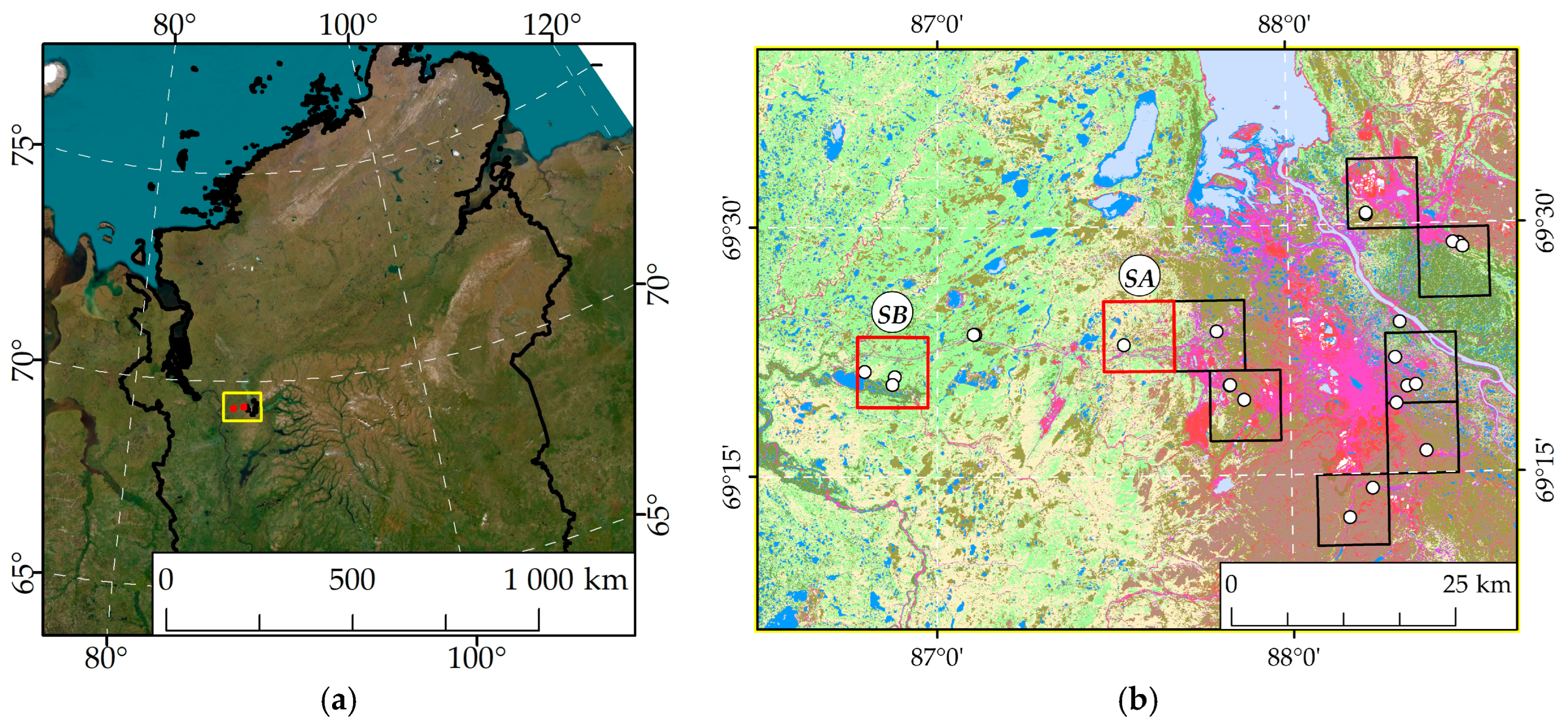
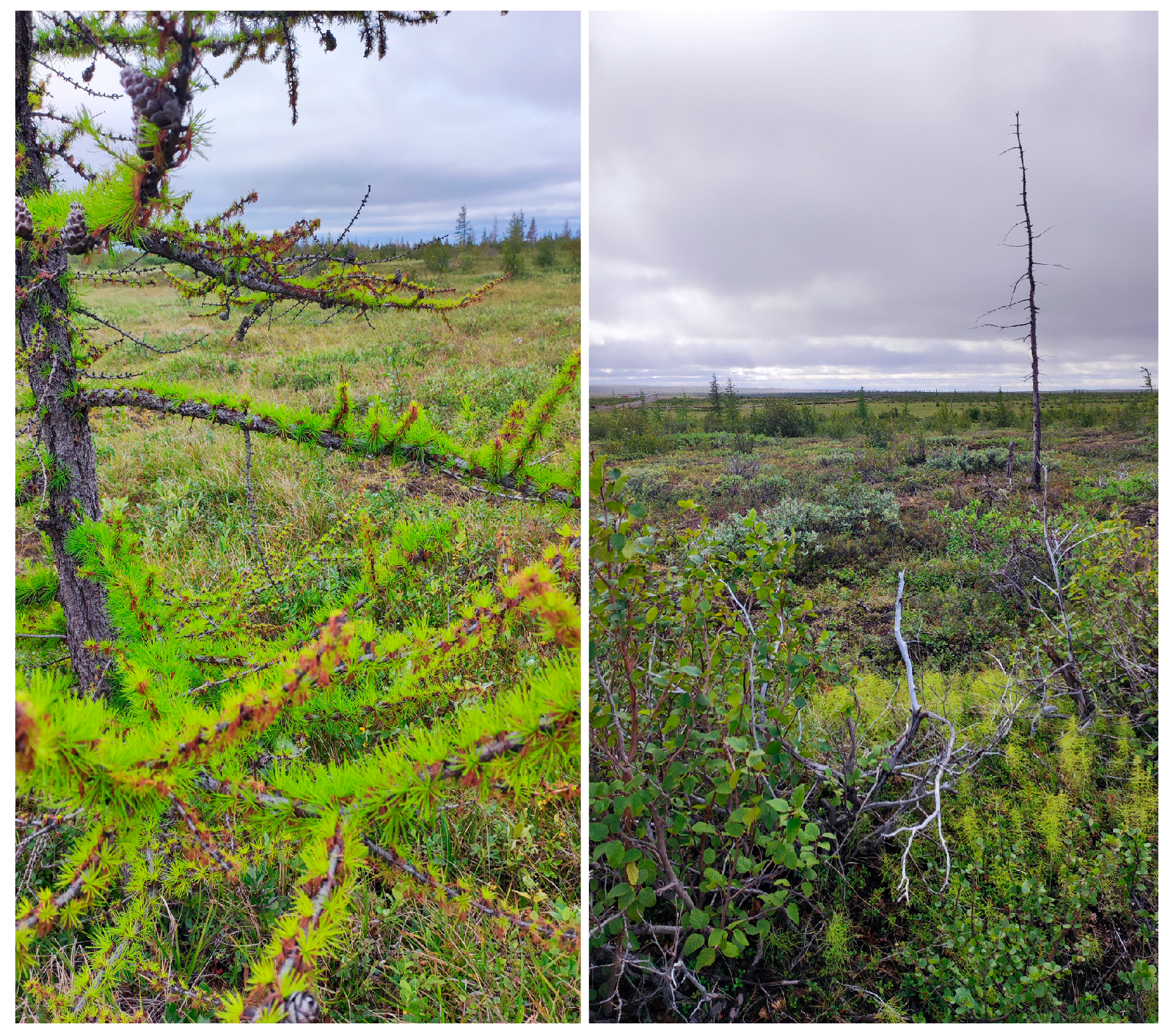

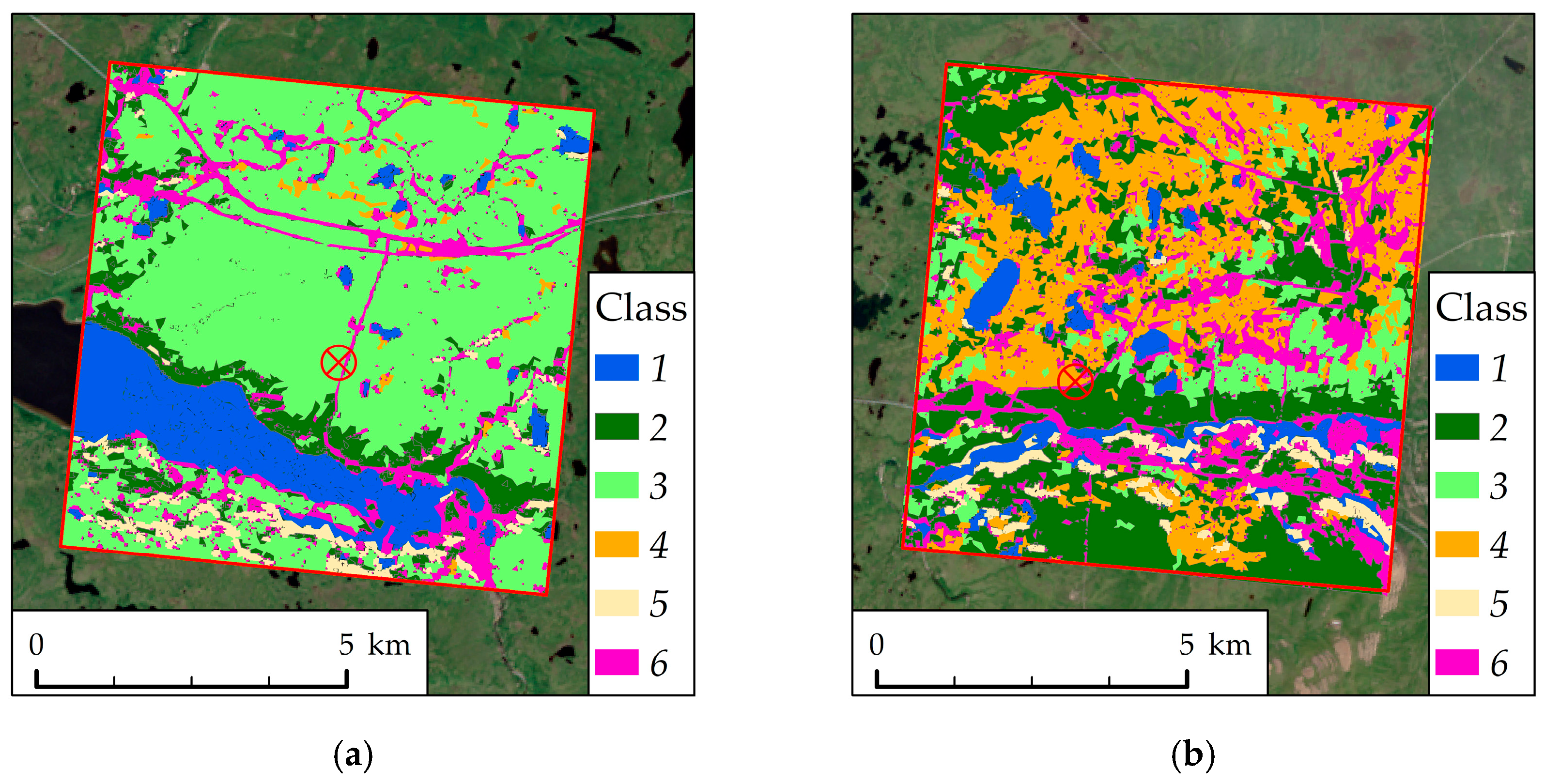

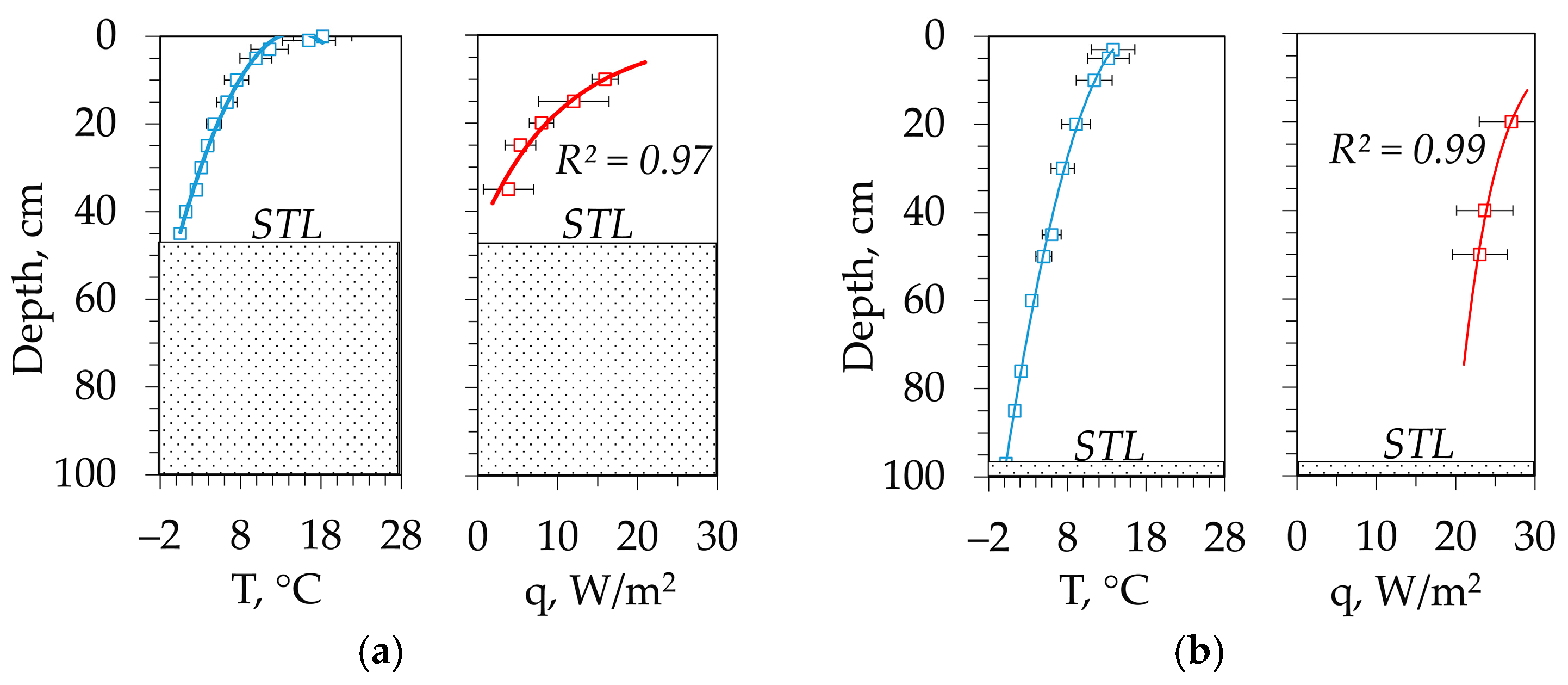
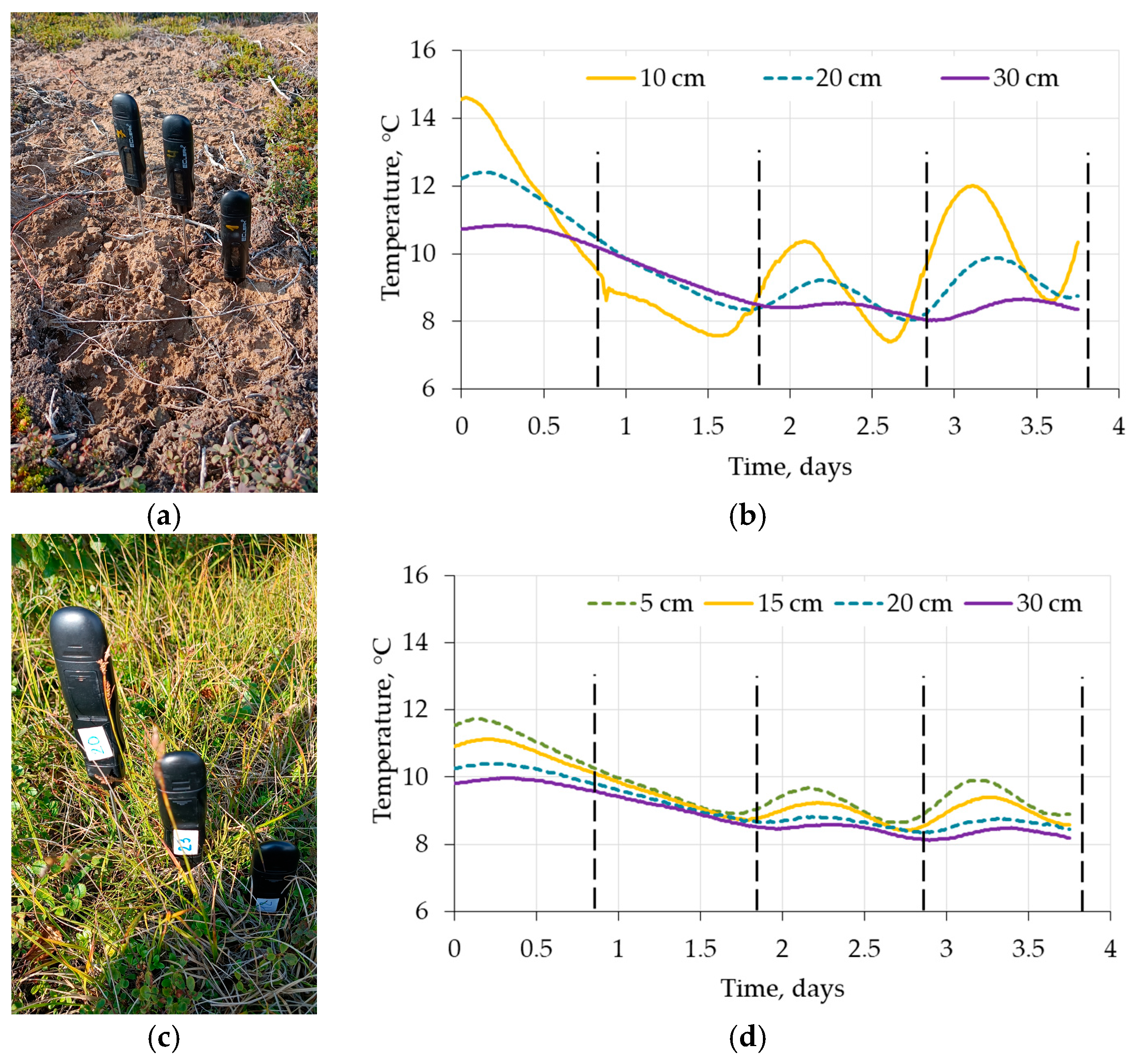


| Class Number | Class Name | SB Test Site | SA Test Site | ||
|---|---|---|---|---|---|
| S, km2 | % of Total | S, km2 | % of Total | ||
| 1 | Water | 5.84 | 4.9 | 1.33 | 2.2 |
| 2 | Sparse tree stand | 7.26 | 12.0 | 20.38 | 33.5 |
| 3 | Shrub tundra vegetation (background state) | 34.89 | 57.5 | 6.98 | 11.5 |
| 4 | Tundra vegetation transformed | 2.47 | 4.1 | 17.11 | 28.1 |
| 5 | Alluvial zone | 5.07 | 8.4 | 3.24 | 5.3 |
| 6 | Technogenic transformation | 5.09 | 8.4 | 9.11 | 15.0 |
| Test Site | Soil Type | Horizons | Depth, cm | Humus/OM *, % | pH, Water | BD **, g/cm3 | SD ***, g/cm3 | MC **** | PC ***** |
|---|---|---|---|---|---|---|---|---|---|
| SB | Histic Cryosols | T | 0–20 | –/91 | 4.6 | 0.13 | 1.4 | 3.35 | – |
| CRg | 20–47 | 3.2 | 5.6 | 0.61 | 2.3 | 0.76 | 38 | ||
| CR┴ | 47–50 | 2.0 | 6.0 | – | 2.3 | – | 52 | ||
| SA | Turbic Cryosols | Oao | 0–5 | –/48 | 5.0 | 0.16 | 1.4 | 1.22 | – |
| CR | 5–42 | 4.9 | 5.8 | 1.07 | 2.4 | 0.33 | 40 | ||
| C | 42–90 | 3.5 | 5.9 | 1.17 | 2.4 | 0.34 | 57 |
| Depth, cm | |||||
|---|---|---|---|---|---|
| SB test site, background state soil | |||||
| 10 | 15.9 ± 2.1 | 0.42/0.25/0.05 | 3.5 ± 10% | 3.35 | 4.4% |
| 15 | 12.0 ± 5.7 | 0.41/0.25/0.05 | |||
| 20 | 8.0 ± 2.0 | 0.37/0.25/0.05 | |||
| 25 | 6.1 ± 2.1 | 0.42/0.25/0.05 | 0.68 ± 30% | 0.76 | −10% |
| 35 | 5.1 ± 1.0 | 0.29/0.25/0.05 | |||
| SA test site, soil of transformed landscape | |||||
| 20 | 33.1 ± 1.4 | 1.35/4.3/0.15 | 0.38 ± 12% | 0.34 | 12% |
| The Soil of Area with a Mineralized Top Layer (Observation Point 1, SA1) | ||||
|---|---|---|---|---|
| Days | Soil Layer | |||
| 10–20 cm | 20–30 cm | 10–20 cm | 20–30 cm | |
| Thermal Diffusivity, mm2/s | ||||
| 2 | 0.5 ± 0.12 | 0.51 ± 0.17 | 0.35 ± 8% | 0.34 ± 12% |
| 3 | 0.5 ± 0.14 | 0.5 ± 0.15 | 0.33 ± 10% | 0.33 ± 11% |
| The Soil of Area with Regenerating Herbaceous Vegetation (Observation Point 2, SA2) | ||||
| Days | Soil Layer | |||
| 15–20 cm | 20–30 cm | 15–20 cm | 20–30 cm | |
| Thermal Diffusivity, mm2/s | ||||
| 2 | 0.52 ± 0.18 | 0.52 ± 0.1 | 0.26 ± 15%/– | 0.27 ± 8%/– |
| 3 | 0.51 ± 0.12 | 0.49 ± 0.09 | 0.32 ± 10%/0.34 | 0.34 ± 7%/0.34 |
Disclaimer/Publisher’s Note: The statements, opinions and data contained in all publications are solely those of the individual author(s) and contributor(s) and not of MDPI and/or the editor(s). MDPI and/or the editor(s) disclaim responsibility for any injury to people or property resulting from any ideas, methods, instructions or products referred to in the content. |
© 2025 by the authors. Licensee MDPI, Basel, Switzerland. This article is an open access article distributed under the terms and conditions of the Creative Commons Attribution (CC BY) license (https://creativecommons.org/licenses/by/4.0/).
Share and Cite
Ponomareva, T.V.; Litvintsev, K.Y.; Finnikov, K.A.; Yakimov, N.D.; Ponomarev, G.E.; Ponomarev, E.I. The Variability in the Thermophysical Properties of Soils for Sustainability of the Industrial-Affected Zone of the Siberian Arctic. Sustainability 2025, 17, 8892. https://doi.org/10.3390/su17198892
Ponomareva TV, Litvintsev KY, Finnikov KA, Yakimov ND, Ponomarev GE, Ponomarev EI. The Variability in the Thermophysical Properties of Soils for Sustainability of the Industrial-Affected Zone of the Siberian Arctic. Sustainability. 2025; 17(19):8892. https://doi.org/10.3390/su17198892
Chicago/Turabian StylePonomareva, Tatiana V., Kirill Yu. Litvintsev, Konstantin A. Finnikov, Nikita D. Yakimov, Georgii E. Ponomarev, and Evgenii I. Ponomarev. 2025. "The Variability in the Thermophysical Properties of Soils for Sustainability of the Industrial-Affected Zone of the Siberian Arctic" Sustainability 17, no. 19: 8892. https://doi.org/10.3390/su17198892
APA StylePonomareva, T. V., Litvintsev, K. Y., Finnikov, K. A., Yakimov, N. D., Ponomarev, G. E., & Ponomarev, E. I. (2025). The Variability in the Thermophysical Properties of Soils for Sustainability of the Industrial-Affected Zone of the Siberian Arctic. Sustainability, 17(19), 8892. https://doi.org/10.3390/su17198892







